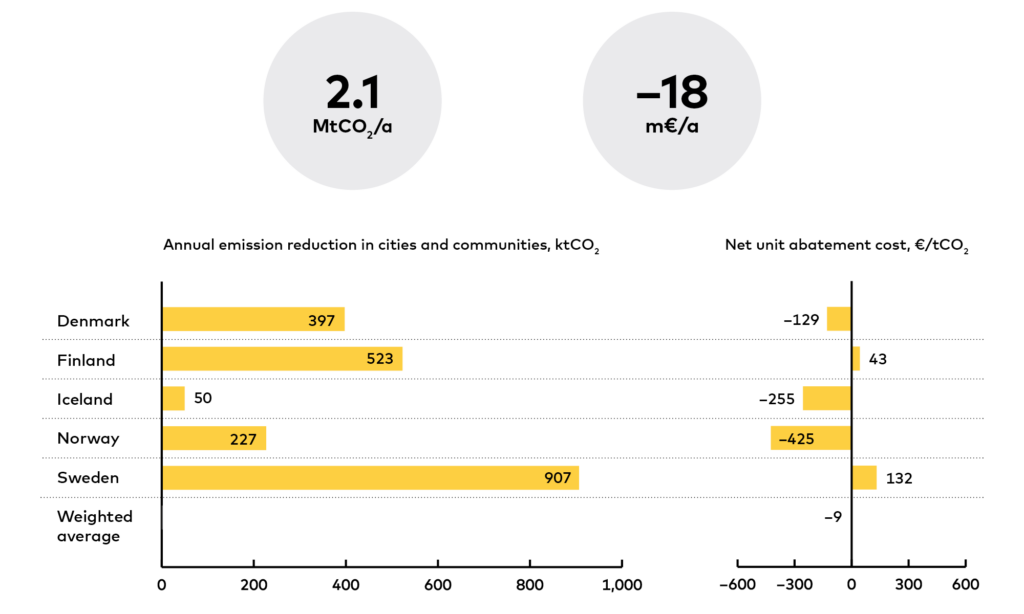Climate impact
Oslo is often called the electric vehicle (EV) capital of the world – 12% of its car fleet was electric in 2018, and another 12% of the car fleet were plug-in hybrids. The success has largely been driven by policy making it cheaper to buy an electric vehicle than a comparable petrol or diesel vehicle. The City of Oslo has encouraged the adoption of electric vehicles by setting up a city-owned network of public charging infrastructure and subsidising the installing of charging points in housing co-operatives and private companies. Oslo has also made electric vehicles exempt from road tolls, eligible for free parking and given them access to co-driving, bus and taxi lanes.
Accounting for the tailpipe emissions and the electricity’s emission factor, we estimate that on average each new electric car instead of a new petrol car reduces annual emissions in the Nordics by 1.4 tCO2. If all the municipalities in the Nordics achieved Oslo’s 12% electric share of the vehicle fleet, it would reduce emissions by 2.1 MtCO2.
For comparison, if we also include the emissions from the car manufacturing and an assumed necessary battery change for an EV, the average annual emission reduction per EV is 1.1 tCO2. However, if we also factor in the emissions from the extraction and refining of the fossil petrol, the average reduction grows again to 1.6 tCO2. This life-cycle emission reduction of EVs compared to petrol cars for the Nordic countries is between 50 and 70%.
Costs and savings
Currently the factory prices of electric vehicles are still relatively high, but the significant tax incentives in Norway have already brought the purchase price to the level of a comparable petrol or diesel vehicle.
Driving with electricity is much cheaper and the maintenance costs are smaller for electric vehicles because of the simpler engine.
The abatement cost faced by the car owner varies significantly between countries as a result of differing taxation and incentives. We estimate the weighted average in the Nordics to be slightly negative, –9 €/tCO2.

Other benefits
Increased use of electric vehicles reduces local pollution, including noise, thereby bringing positive health effects to cities. EVs are more comfortable to drive than conventional cars because of their quicker acceleration and seamless operation of the gearless engine. Through smart charging, electric vehicles can be used to balance the electricity demand in the grid. EVs can also use locally produced clean electricity, reducing oil imports and improving energy security.
Barriers
- Electric cars are still more expensive to buy, particularly in the absence of substantial incentives.
- There is limited experience of how an electric car will hold its value in the longer term.
- The lack of a public charging infrastructure, the fear of short driving ranges and the still limited number of car models available also slow down deployment.
- Installing multiple charging points in housing co-operatives often requires upgrading the electric cable capacity and brings extra costs.
Enablers
- The most important drivers of the EV revolution in Norway have been the incentives that have brought down the prices of electric cars to the level comparable to petrol and diesel vehicles.
- Electric vehicles are expected to get cheaper, turning the total cost ownership in favour of EVs even without the incentives.
- Oslo has also developed an extensive public charging infrastructure, provided support for retrofitting charging points in buildings and given preferential toll and parking charge treatment to EVs.
- The availability of reliable information on new technologies and their lifetime costs helps consumers make purchase decisions.
- Leasing the vehicle instead of buying it eliminates the need for the consumer to make a large investment and transfers the risk of a fast decrease in value to the leasing company.
- New smart charging systems are able to manage the load in buildings and can make the existing cables go further.

























RELATED SOLUTIONS